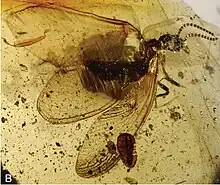1949 in paleontology
Paleontology or palaeontology is the study of prehistoric life forms on Earth through the examination of plant and animal fossils.[1] This includes the study of body fossils, tracks (ichnites), burrows, cast-off parts, fossilised feces (coprolites), palynomorphs and chemical residues. Because humans have encountered fossils for millennia, paleontology has a long history both before and after becoming formalized as a science. This article records significant discoveries and events related to paleontology that occurred or were published in the year 1949.
| |||
|---|---|---|---|
| +... |
Arthropods
Insects
| Name | Novelty | Status | Authors | Age | Unit | Location | Notes | Images |
|---|---|---|---|---|---|---|---|---|
| Parastylotermes[2] | Gen. 4 comb nov | valid | Snyder & Emerson | Ypresian-Miocene | Latah Formation | A Stylotermitid termite genus. The type species is Stylotermes washingtonensis Also includes S. calico, S. frazieri, & S. robustus. |
||
| Ulmeriella latahensis[3] | Sp nov. | Valid | Snyder | Miocene | Latah Formation | A harvester termite | ||
Archosauromorphs
Archosauromorphs
| Name | Novelty | Status | Authors | Age | Location | Notes | Images |
|---|---|---|---|---|---|---|---|
| Elachistosuchus | Gen et sp nov | valid | Janensch | Late Triassic (Norian) | * |
A neodiapsid reptile. | |
Plesiosaurs
- Plesiosaur gastroliths documented.[4]
Synapsids
Non-mammalian
| Name | Status | Authors | Age | Location | Notes | Images |
|---|---|---|---|---|---|---|
| Jr. Synonym of Theriognathus. | Broom and Robinson | Wuchiapingian | ||||
| Valid | Broom | Wuchiapingian | A therocephalian | |||
| Lemurosaurus | Valid | Broom | Wuchiapingian | * |
A biarmosuchian | |
| Valid | Broom | Wuchiapingian | A dicynodont | |||
Other Animals
| Name | Novelty | Status | Authors | Age | Location | Notes | Images |
|---|---|---|---|---|---|---|---|
| Dickinsonia minima[5] | Sp nov | Synonym of Dickinsonia costata | Sprigg | Ediacaran |
References
- Gini-Newman, Garfield; Graham, Elizabeth (2001). Echoes from the past: world history to the 16th century. Toronto: McGraw-Hill Ryerson Ltd. ISBN 9780070887398. OCLC 46769716.
- Emerson, A.E. (1971). "Tertiary fossil species of the Rhinotermitidae (Isoptera), phylogeny of genera, and reciprocal phylogeny of associated Flagellata (Protozoa) and the Staphylinidae (Coleoptera)". Bulletin of the American Museum of Natural History. 146 (3): 243–304.
- Snyder, T. (1949). "A new Miocene Ulmeriella (fossil Isoptera, Hodotermitidae)". Proceedings of the Entomological Society of Washington. 51 (4): 164–165.
- Welles and Bump (1949). Sanders, Manley, and Carpenter (2001), "Table 12.1" page 167.
- Sprigg, R.C. (1949). "Early Cambrian "jellyfishes" of Ediacara, South Australia, and Mount John, Kimberley District, Western Australia" (PDF). Transactions of the Royal Society of South Australia. 73: 72–99.
- Welles, Samuel P. and Bump, J. D.; 1949; Alzadasaurus pembertoni, a new elasmosaur from the Late Cretaceous of South Dakota; Journal of Paleontology; 23(5) pp. 521–535
- Sanders F, Manley K, Carpenter K. Gastroliths from the Lower Cretaceous sauropod Cedarosaurus weiskopfae. In: Tanke D.H, Carpenter K, editors. Mesozoic vertebrate life: new research inspired by the paleontology of Philip J. Currie. Indiana University Press; Bloomington, IN: 2001. pp. 166–180.
This article is issued from Wikipedia. The text is licensed under Creative Commons - Attribution - Sharealike. Additional terms may apply for the media files.

